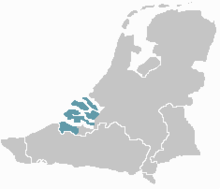Zeelandic
Zeelandic (Zeeuws: Zeêuws; Dutch: Zeeuws; West Flemish: Zêeuws) is a Low Franconian dialect of Dutch spoken in the southwestern parts of the Netherlands. More specifically, it is spoken in the southernmost part of South Holland (Goeree-Overflakkee) and large parts of the province of Zeeland, with the notable exception of eastern Zeelandic Flanders.[3]
| Zeelandic | |
|---|---|
| Zeêuws | |
| Native to | Zeeland (Netherlands) |
Native speakers | (undated figure of 220,000)[1] |
Early forms | Frankish
|
| Zeelandic alphabet (Latin) | |
| Language codes | |
| ISO 639-3 | zea |
| Glottolog | zeeu1238[2] |
| Linguasphere | 52-ACB-af |
 Distribution of Zeelandic (blue) in the Low Countries | |
| This article is a part of a series on |
| Dutch |
|---|
| Dutch Low Saxon dialects |
| West Low Franconian dialects |
| East Low Franconian dialects |
|
It has notable differences from Standard Dutch mainly in pronunciation but also in grammar and vocabulary, which separates it clearly from Standard Dutch. They make mutual intelligibility with speakers of Standard Dutch difficult.
Origin
In the Middle Ages and the early modern period, Zeeland was claimed by the Count of Holland as well as the Count of Flanders, and the area was exposed to influence from both directions. The dialects clearly show a gradual increase of Hollandic elements as one goes northwards. However, Zeelandic is fairly coherent with clear borders, as the broad sea arms form strong isoglosses.
Characteristics
Zeelandic still has three grammatical genders and the final schwa of feminine words. It has kept the monophthongs [i] and [y] for ij and ui, rather than breaking them into [ɛi] and [œy]. It usually umlauts [aː] into [ɛː] and renders the old Germanic [ai] and [au] as falling diphthongs ([ɪə ~ ɪɐ ~ iɐ] and [ʊə ~ ʊɐ ~ uɐ], respectively, with the exact realisation depending on the dialect. Standard Dutch has merged them with etymological [eː] and [oː]. Finally, Zeelandic drops [h].
This table illustrates the differences (note that the orthography is Dutch):
| Zeelandic | Dutch | English |
| d'n boer | de boer | the (male) farmer |
| de boerinne | de boerin | the (female) farmer |
| uus | huis | house |
| kieke(n) | kijken | to look |
| tweê | twee | two |
| oôd | hoofd | head |
| luust'ren | luisteren | to listen |
| jie | jij | you |
| piele | eend | duck |
Dialects
The province of Zeeland consists of several former islands that were difficult to reach until well into the 20th century. As a result, there is roughly one dialect per island. The respective dialects differ clearly but only slightly. The Goeree-Overflakkee dialect, for example, does not drop the h, and the Walcheren and Zuid-Beveland dialects have umlauted words, unlike the northern dialects (for example: beuter [bøtər] as opposed to boter [botər]. Within the island dialects themselves, dialectal differences also exist, and native speakers can frequently tell the village (at least on their own island) a person is from by the specific dialect that is spoken, even if the differences are inaudible to outsiders. For example within the Tholen dialect, speakers from Poortvliet, a village roughly on the middle of the island, can use widely differend words for something than speakers from Sint-Maartensdijk do, which lies only 5 km to the west of Poortvliet.
Geographic distribution and social aspects
Zeelandic bears the burden of being strongly associated with the rural population, as it is spoken mainly in the countryside. The town dialects of Middelburg and Vlissingen are both much closer to Hollandic than the rural variants and are almost extinct. Surveys held in the 1990s found that at least 60% of Zeeland's population still use Zeelandic as their everyday language. An estimated 250,000 people speak Zeelandic as a mother tongue (West Zeelandic Flemish is included in that count), and although it is in decline, just as other regional languages, it is in no direct danger of extinction since in some villages with strong isolated communities, more than 90% of the youngsters still speak Zeelandic. On the other hand, in several villages with much immigration, the local dialect is spoken only by adults, as children are no longer taught it. A lobby for recognising the Zeelandic regional language under the European Charter for Minority Languages has, as of 2005, failed to achieve that status.
Gallery
 Zeelandic sign in Driewege, "Durpsuus", which is Zeelandic for a Community centre.
Zeelandic sign in Driewege, "Durpsuus", which is Zeelandic for a Community centre. "Juun", Zeelandic for onion(s)
"Juun", Zeelandic for onion(s)
References
- Zeelandic at Ethnologue (15th ed., 2005)
- Hammarström, Harald; Forkel, Robert; Haspelmath, Martin, eds. (2017). "Zeeuws". Glottolog 3.0. Jena, Germany: Max Planck Institute for the Science of Human History.
- Marco Evenhuis. "Zeelandic". Language in the Netherlands. Streektaal.net. Retrieved 2007-06-03.
Together with West-Flemish and the Flemish spoken in northern France, Zeeuws is part of a cluster of remarkably homogenic dialects
Dutch versions: Zeeuws or as pdf
Further reading
- Berns, J. B. (1999), "Zierikzee", in Kruijsen, Joep; van der Sijs, Nicoline (eds.), Honderd Jaar Stadstaal (PDF), Uitgeverij Contact, pp. 223–232
External links
| Zeelandic edition of Wikipedia, the free encyclopedia |
